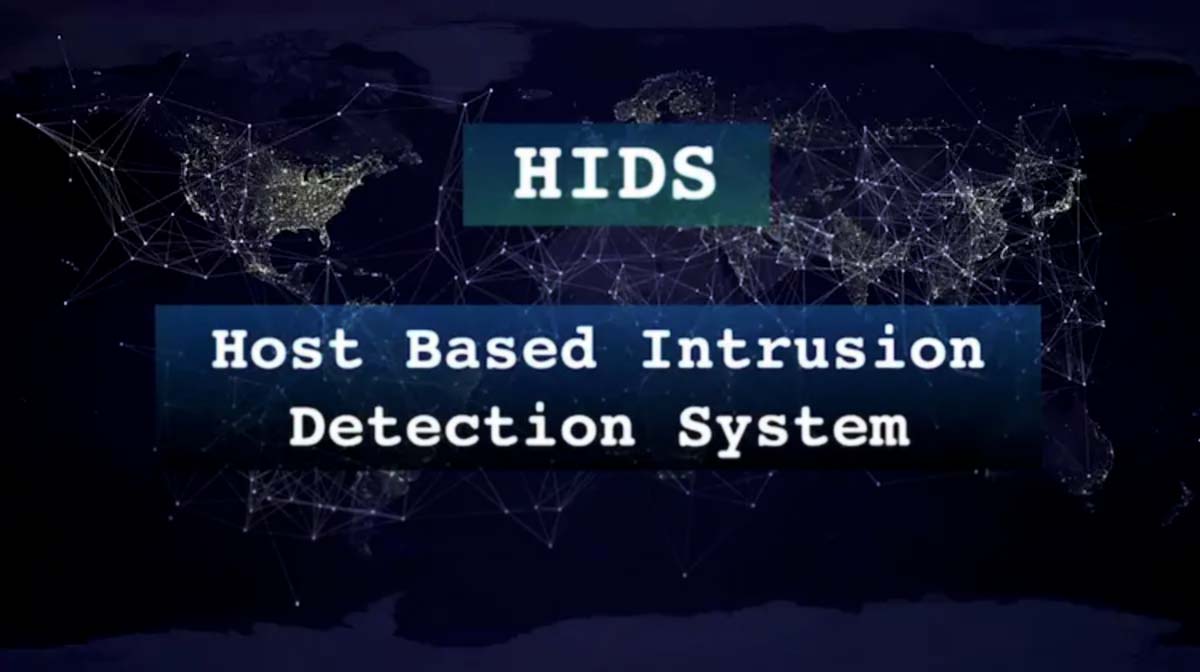Home>Home Security and Surveillance>Which Describes An Intrusion Detection System


Home Security and Surveillance
Which Describes An Intrusion Detection System
Modified: October 21, 2024
Find the best home security and surveillance system with an effective intrusion detection system. Protect your property with advanced technology.
(Many of the links in this article redirect to a specific reviewed product. Your purchase of these products through affiliate links helps to generate commission for Storables.com, at no extra cost. Learn more)
Introduction
Welcome to the world of home security and surveillance, where peace of mind and the safety of your loved ones are paramount. In today’s fast-paced society, it is crucial to protect our homes from potential threats, both physical and virtual. This is where an Intrusion Detection System (IDS) comes into play.
An Intrusion Detection System is a vital component of any comprehensive home security setup. It acts as a vigilant watchdog, continuously monitoring your premises and alerting you in the event of unauthorized access or suspicious activities. With the advancements in technology, IDS has become more sophisticated, providing homeowners with an extra layer of protection and peace of mind.
In this article, we will explore the world of Intrusion Detection Systems, shedding light on their types, components, functionality, benefits, challenges, and best practices. Whether you are a homeowner looking to increase the security of your property or a tech enthusiast seeking to delve deeper into the intricacies of IDS, this article will serve as a comprehensive resource.
So, let’s dive in and discover how an Intrusion Detection System can provide you with the security and peace of mind you deserve.
Key Takeaways:
- Intrusion Detection Systems (IDS) act as vigilant guardians, detecting potential threats and safeguarding networks. They offer early threat detection, reduced response time, and enhanced network visibility, ensuring robust security.
- Implementing an IDS requires careful planning, regular updates, and ongoing management. Choosing the right IDS type, strategic sensor placement, and staff training are crucial for successful implementation.
What is an Intrusion Detection System?
An Intrusion Detection System, commonly referred to as IDS, is a security mechanism designed to detect unauthorized or malicious activities within a network or system. Just like a security guard patrolling a building, an IDS constantly scans and monitors network traffic and system logs, identifying any suspicious behavior or potential threats.
The primary goal of an IDS is to identify and respond to intrusions, whether they are external attacks from hackers or internal attempts by unauthorized personnel. By detecting and alerting users to any signs of intrusion, an IDS plays a crucial role in preventing potential security breaches and safeguarding against data theft, unauthorized access, and other cyber threats.
There are two primary types of Intrusion Detection Systems: Network-based IDS (NIDS) and Host-based IDS (HIDS).
A Network-based IDS is deployed at strategic points within a network infrastructure to monitor all incoming and outgoing traffic. It analyzes network packets and payloads, looking for patterns and anomalies that indicate potential attacks. NIDS can identify various types of attacks, such as port scans, Denial of Service (DoS) attacks, and suspicious traffic patterns.
On the other hand, a Host-based IDS is installed on individual computer systems or servers. It monitors system logs, file integrity, and user activities to detect any unauthorized changes or suspicious behavior at the host level. HIDS can detect malicious files, unauthorized access attempts, and suspicious user activities, providing a more granular level of security within a network.
IDS systems operate through a combination of signature-based detection and anomaly-based detection techniques. Signature-based detection involves comparing network traffic or system events against a database of known attack signatures. If a match is found, the IDS generates an alert. Anomaly-based detection, on the other hand, establishes a baseline of normal behavior and constantly monitors for deviations from the norm. If any abnormal behavior is detected, the IDS raises an alert.
Overall, an Intrusion Detection System is a crucial component of any comprehensive security strategy, allowing organizations and homeowners to actively monitor and protect their networks and systems against potential threats. By leveraging the power of IDS, you can fortify your defenses and ensure the safety and integrity of your digital infrastructure.
Types of Intrusion Detection Systems
Intrusion Detection Systems (IDS) come in various types, each tailored to specific security needs and environments. Understanding the different types of IDS can help you choose the most suitable system for your home or organization. Here are some common types of IDS:
- Network-Based IDS (NIDS): This type of IDS focuses on monitoring network traffic flowing through specific points in the network infrastructure. It analyzes packets and payloads, comparing them against a database of known attack signatures. NIDS can identify port scans, DoS attacks, and other network-level intrusions. It provides a centralized view of network security and is often deployed at critical junctures, such as firewalls or intrusion points.
- Host-Based IDS (HIDS): Unlike NIDS, HIDS is installed on individual computer systems or servers. It monitors system logs, file integrity, and user activities to detect any unauthorized changes or suspicious behavior at the host level. HIDS provides a more granular level of security, enabling the detection of insider threats and unauthorized access attempts.
- Wireless IDS (WIDS): WIDS specializes in securing wireless networks. As wireless networks are more susceptible to unauthorized access and eavesdropping, a WIDS monitors radio frequency signals, network traffic, and access points to identify potential security breaches. It can detect rogue access points, unauthorized devices, and other wireless-specific threats.
- Network Behavior Analysis (NBA): NBA IDS focuses on monitoring network behavior and identifying anomalies that may indicate malicious activities. Instead of relying solely on known attack signatures, NBA IDS establishes a baseline of normal network behavior and raises alerts when deviations occur. This type of IDS is effective in detecting unknown or zero-day attacks.
- Application-Based IDS (AIDS): AIDS is designed to monitor and protect specific applications or services within a network. It focuses on the detection of application-layer attacks, such as SQL injections or cross-site scripting (XSS). By analyzing application-specific traffic and behavior, AIDS can identify and mitigate application-level vulnerabilities.
- Cloud-Based IDS (CIDS): With the increasing adoption of cloud computing, CIDS has gained prominence. It focuses on securing cloud environments by monitoring network traffic, virtual machines, and user activities within the cloud infrastructure. CIDS helps detect unauthorized access, data breaches, and other cloud-specific threats.
These are just some of the common types of IDS available today. It is important to choose the appropriate IDS based on your specific security requirements, network architecture, and budget. Implementing the right combination of IDS types can provide a robust security posture and safeguard your home or organization from potential security threats.
Components of an Intrusion Detection System
An Intrusion Detection System (IDS) comprises several essential components that work together to effectively detect and respond to potential network intrusions. Understanding these components can help you make informed decisions when implementing an IDS. Let’s explore the key components of an IDS:
- Sensors: Sensors are responsible for collecting data from various sources, such as network traffic, system logs, and user activities. These sensors act as the eyes and ears of the IDS, continuously monitoring for suspicious behavior or anomalies. Sensors can be deployed at different points within the network infrastructure, including network switches, routers, and servers.
- Analysis Engine: The analysis engine is the brain of the IDS. It receives data from the sensors and processes it to identify potential threats. This component utilizes various techniques, such as signature-based detection, anomaly detection, and data correlation, to determine if an intrusion has occurred. The analysis engine applies pre-defined rules and algorithms to analyze the collected data and generate alerts when necessary.
- Alerting System: The alerting system is responsible for notifying system administrators or users when potential intrusions are detected. Alerts can be in the form of email notifications, text messages, or pop-up notifications on a central management console. The alerting system helps ensure that potential threats are promptly addressed, allowing for quick response and mitigation.
- Central Management Console: The central management console provides a centralized interface for managing and configuring the IDS. Administrators can access the console to view alerts, adjust IDS settings, update rulesets, and perform other administrative tasks. The central management console enhances the usability of the IDS by providing a consolidated view of the security landscape.
- Database: The database component is responsible for storing and managing various data related to the IDS, such as logs, event history, and user information. It allows for efficient retrieval and analysis of historical data, aiding in forensic investigations and compliance reporting. The database also plays a crucial role in generating reports and statistics regarding network security incidents.
These components work together seamlessly to provide a comprehensive Intrusion Detection System. It is important to ensure that each component is properly configured, integrated, and maintained to maximize the effectiveness of the IDS. Regular updates, rule customization, and fine-tuning of thresholds are essential to ensure accurate detection and minimize false positives.
By understanding the components of an IDS, you can make informed decisions regarding its implementation and configuration, thus enhancing the security of your network and systems.
How Intrusion Detection Systems Work
Intrusion Detection Systems (IDS) employ a combination of techniques and methodologies to detect and respond to potential network intrusions. Understanding how IDS works can help you grasp the underlying mechanisms that enable these systems to effectively safeguard your network and data. Here’s a simplified explanation of how IDS operates:
Data Collection: The IDS collects data from various sources, such as network traffic, system logs, and user activities. Sensors strategically deployed within the network infrastructure capture and feed this data to the IDS for analysis.
Anomaly Detection: IDS uses anomaly detection techniques to establish a baseline of normal behavior. It learns patterns and characteristics of normal network traffic, system events, and user behavior, allowing it to identify anomalies that deviate from the established baseline. These anomalies can be indicators of potential intrusions.
Signature-based Detection: Another approach used by IDS is signature-based detection. It involves comparing data against a database of known attack signatures. If a match is found, indicating a known threat or attack pattern, the IDS generates an alert. Signatures can be based on patterns, file hashes, or specific behaviors associated with known attacks.
Rule-based Detection: IDS may also employ rule-based detection, where predefined rules or policies are set to identify specific activities or events that are considered suspicious or malicious. These rules help in identifying potential threats and generating alerts based on certain criteria or conditions.
Data Analysis and Correlation: The collected data is then analyzed and correlated using sophisticated algorithms and rule sets. This process involves examining the data for patterns, anomalies, or matches against known signatures and rules. It helps in identifying potential security breaches and distinguishing legitimate activities from malicious ones.
Alert Generation and Notification: When the IDS identifies potential intrusions or suspicious activities, it generates alerts to inform system administrators or security personnel. These alerts include relevant information, such as the nature of the intrusion, the affected system or network, and any necessary actions to be taken.
Response and Mitigation: Based on the severity and type of intrusion detected, the IDS triggers an appropriate response and mitigation strategy. This may involve blocking certain IP addresses, quarantining compromised systems, or initiating an incident response plan to address the incident effectively.
Logging and Reporting: IDS logs all detected events, including alerts, and maintains a comprehensive record of network activity. This data is invaluable for forensic investigations, compliance reporting, and identifying potential weaknesses or vulnerabilities in the network infrastructure.
In summary, an Intrusion Detection System continuously monitors network traffic, system logs, and user activities to identify potential intrusions or suspicious behavior. By combining anomaly detection, signature-based detection, rule-based detection, and data correlation, IDS works to detect and respond to security threats, allowing for timely action to mitigate potential risks.
It is important to regularly update and maintain the IDS, including updating signatures, rulesets, and analysis engines, to stay ahead of evolving threats and ensure effective detection and response to potential intrusions.
Read more: How To Test Intrusion Detection System
Benefits of Using an Intrusion Detection System
An Intrusion Detection System (IDS) offers numerous benefits for both homeowners and organizations, helping to ensure the security and integrity of their networks and systems. Here are some key advantages of implementing an IDS:
- Early Threat Detection: IDS actively monitors network traffic, system logs, and user activities, allowing for the early detection of potential threats. By identifying suspicious behavior or anomalies, IDS can alert users to potential intrusions, providing an opportunity to act promptly and prevent further damage.
- Reduced Response Time: With IDS in place, the response time to security incidents is significantly reduced. IDS generates alerts in real-time, enabling quick response and mitigation measures. This helps in minimizing the impact of an intrusion, preventing data breaches, and safeguarding critical systems and information.
- Enhanced Network Visibility: IDS provides a comprehensive view of network traffic and activities. It helps identify patterns, trends, and potential vulnerabilities within the network infrastructure. With better network visibility, administrators can proactively address security weaknesses, optimize network performance, and ensure efficient resource allocation.
- Protection Against “Zero-Day” Attacks: IDS with anomaly detection capabilities can identify unknown or “zero-day” attacks that have not been previously identified or documented. By analyzing deviations from normal behavior, IDS can detect and raise alarms for these new and evolving threats, providing a valuable defense against emerging attack vectors.
- Compliance and Audit Support: IDS generates detailed logs and event records, aiding in compliance with regulatory requirements and facilitating security audits. These logs provide a record of security incidents, helping organizations demonstrate due diligence and adherence to industry regulations.
- Reduced False Positives: IDS has evolved to minimize false positives, which are alerts triggered by legitimate activities mistaken for security threats. Modern IDS systems use advanced algorithms, machine learning, and threat intelligence to accurately distinguish between normal and malicious activities, reducing the incidence of false positives and minimizing unnecessary disruptions.
- Improved Incident Response: IDS provides valuable information about the nature and scope of security incidents. This aids incident response teams in effectively managing and containing security breaches. The detailed alerts and event logs enable forensic investigations, allowing organizations to understand the root cause and take appropriate measures to prevent similar incidents in the future.
- Cost-Effective Security: Implementing an IDS can be cost-effective compared to the potential losses resulting from security breaches. IDS helps mitigate the financial and reputational risks associated with data breaches, system compromises, and unauthorized access attempts. The investment in IDS typically pays off by preventing costly incidents and ensuring business continuity.
Overall, an Intrusion Detection System offers a range of benefits, including early threat detection, reduced response time, enhanced network visibility, and protection against both known and unknown security threats. By implementing an IDS, organizations and homeowners can proactively defend their networks and systems, maintaining a secure and resilient digital environment.
An Intrusion Detection System (IDS) is a security tool that monitors network or system activities for malicious activities or policy violations. It can be either network-based or host-based, and it alerts the system or network administrator when it detects any suspicious behavior.
Challenges and Limitations of Intrusion Detection Systems
While Intrusion Detection Systems (IDS) serve as valuable tools in detecting and mitigating potential security threats, they also face certain challenges and limitations. Understanding these limitations can help in effectively managing the expectations and maximizing the effectiveness of IDS implementations. Let’s explore some common challenges and limitations of IDS:
- False Positives and False Negatives: IDS may generate false alarms, known as false positives, when legitimate activities are mistaken for security threats. Conversely, false negatives occur when IDS fails to identify actual intrusions. Striking the right balance between accuracy and detection rate is a constant challenge for IDS implementations.
- Evolving and Sophisticated Attacks: As attackers become more advanced and employ new techniques, IDS must keep up with the ever-evolving threat landscape. Detecting unknown or zero-day attacks, polymorphic malware, and sophisticated evasion techniques poses a significant challenge for IDS, as they may not have the necessary signatures or patterns to identify these novel threats.
- Increased Network Traffic: IDS operates by analyzing network traffic, and as network traffic volumes increase, IDS may face challenges in processing and analyzing the vast amount of data. This can result in delayed detection or resource limitations, where IDS may struggle to handle high-bandwidth networks without affecting overall performance.
- Encrypted Traffic: With the widespread use of encryption protocols such as SSL/TLS, IDS may face difficulties in inspecting encrypted traffic. Encrypted traffic poses a challenge for IDS as it obscures the content being transmitted, making it challenging to detect potential malicious activities or intrusions hidden within encrypted communications.
- Complex Rule Management: IDS rulesets can become complex and extensive, requiring ongoing configuration and management. Updating rules, adding new signatures, and maintaining a solid rule management process can be time-consuming and resource-intensive. Failure to properly manage rulesets can lead to inefficient detection or an increased likelihood of false positives.
- Resource Requirements: IDS implementations require dedicated hardware, software, and skilled personnel to ensure optimal performance. Meeting the resource requirements, including network bandwidth, processing power, and storage for event logs, can be a challenge for organizations with limited budgets or complex network infrastructures.
- Privacy Concerns: IDS involves collecting and analyzing network traffic and system logs, which can raise privacy concerns among employees or users. Striking the right balance between security and privacy is crucial to maintain trust and ensure compliance with data protection regulations.
Despite these challenges and limitations, IDS remains an important component of a comprehensive security strategy. Recognizing and addressing these limitations through continuous monitoring, rule fine-tuning, and regular updates help in maximizing the efficiency and effectiveness of IDS implementations.
It is important to supplement IDS with other security measures, such as firewall systems, endpoint protection, and employee training, to create layers of defense and enhance overall security posture. A holistic approach to security ensures a resilient and proactive defense against potential threats.
Best Practices for Implementing an Intrusion Detection System
Implementing an Intrusion Detection System (IDS) requires careful planning, configuration, and ongoing maintenance to ensure optimal effectiveness and efficiency. Here are some best practices to consider when implementing an IDS:
- Define Clear Objectives: Clearly define the objectives and goals of implementing an IDS. Understand what you want to achieve and the specific security requirements of your network or organization.
- Conduct Risk Assessment: Perform a comprehensive risk assessment to identify potential vulnerabilities, threats, and attack vectors. This will help in determining the areas and assets that require additional monitoring and protection.
- Choose the Right IDS Type: Select the appropriate IDS type based on your specific needs and network architecture. Consider factors such as network size, complexity, and the level of security required.
- Place Sensors Strategically: Deploy IDS sensors strategically in critical network segments, such as entry points and high-value assets. This ensures efficient coverage and accurate detection across the network.
- Regularly Update and Maintain Signatures: Keep your IDS signatures up to date with the latest threat intelligence. Regularly update and maintain your IDS to ensure it is equipped to detect and respond to the latest threats.
- Tailor Rulesets to Your Environment: Customize IDS rulesets to suit your network environment, applications, and specific security policies. Fine-tuning rule thresholds and eliminating false positives will improve accuracy and reduce unnecessary alerts.
- Enable Network Segmentation: Implement network segmentation to isolate critical assets and create security zones. This reduces the attack surface and limits the potential impact of a security breach.
- Monitor and Analyze Logs: Regularly monitor and analyze IDS logs to identify patterns, trends, and potential security incidents. Correlate IDS logs with other security event logs and system logs to gain a comprehensive view of the security landscape.
- Integrate with Security Information and Event Management (SIEM): Integrate your IDS with SIEM systems to centralize security event information. SIEM provides a consolidated view of security events, enabling better correlation, analysis, and response to potential threats.
- Train and Educate Staff: Establish training programs to educate employees about the importance of IDS and how to respond to IDS alerts. Promote a culture of security awareness and encourage reporting of any suspicious activities.
- Regularly Test and Evaluate: Conduct regular penetration testing and vulnerability assessments to evaluate the effectiveness of your IDS. Identify any weaknesses or gaps in your security infrastructure and take appropriate actions to address them.
- Stay Informed about Emerging Threats: Keep yourself updated with the latest security trends, emerging threats, and advancements in IDS technology. Stay informed about new attack vectors, vulnerabilities, and mitigation techniques.
By following these best practices, you can ensure that your IDS is properly configured, effectively monitoring your network, and providing the necessary security measures to protect against potential threats.
Remember, implementing an IDS is not a one-time task. It requires ongoing management, regular updates, and continuous monitoring to adapt to evolving threats and maintain an effective security posture.
Comparison of Popular Intrusion Detection Systems
When selecting an Intrusion Detection System (IDS) for your home or organization, it is important to assess the features, capabilities, and limitations of different options available in the market. Here is a comparison of some popular IDS solutions:
- Snort: Snort is an open-source NIDS that is widely recognized in the cybersecurity community. It is highly customizable, with a large and active user community that contributes to its rule and signature database. Snort offers robust packet analysis, protocol detection, and supports a range of preprocessors and plugins for enhanced functionality. However, Snort requires experienced administrators to fine-tune its configuration and regularly update rulesets.
- Suricata: Suricata is another open-source NIDS that boasts high-speed performance and scalability. It is known for its multi-threaded architecture, which enables it to handle high network traffic volumes. Suricata supports a wide range of network protocols, implements both signature-based and behavioral analysis, and offers an extensible rule language. However, it requires more system resources compared to other IDS solutions.
- Bro Network Security Monitor: Bro, now known as Zeek, is an open-source NIDS designed to provide comprehensive network visibility. It focuses on providing detailed network logs rather than real-time alerting. Bro excels in protocol analysis, supporting a wide range of protocols and enabling comprehensive network monitoring. Its scripting language allows advanced customization, but it may require more effort to set up and analyze logs effectively.
- Snort-based commercial solutions: Numerous commercial IDS solutions are built upon the Snort framework, such as Cisco Snort, Sourcefire, and TippingPoint. These solutions offer additional features, support, and user-friendly interfaces compared to the open-source version. They often provide centralized management consoles, advanced correlation capabilities, and integration with other security tools. However, the commercial offerings may come with licensing fees and ongoing maintenance costs.
- Suricata-based commercial solutions: Similar to Snort, some commercial IDS solutions are based on the Suricata engine, such as Suricata Enterprise, SELKS, and Suricata IDS. These solutions offer additional features like high-performance network traffic analysis, threat intelligence integration, and advanced event correlation. They provide user-friendly interfaces and comprehensive reporting capabilities. However, they may also come with licensing costs and require dedicated hardware for optimal performance.
- Security Onion: Security Onion is a popular open-source IDS platform that combines multiple security tools, including Snort, Suricata, and Bro. It provides a unified interface for network monitoring, intrusion detection, and log analysis. Security Onion offers centralized management, extensive data visualization, and easy deployment through pre-configured virtual machine images. It is a versatile IDS solution suitable for small to mid-sized organizations. However, its all-in-one nature may result in higher resource requirements.
- Commercial Host-based IDS (HIDS): Various commercial HIDS solutions are available, such as Symantec Endpoint Protection, McAfee Host Intrusion Prevention System (HIPS), and Trend Micro Deep Security. These solutions focus on monitoring and protecting individual hosts and endpoints. They offer features like file integrity monitoring, system behavior analysis, and real-time threat detection. Commercial HIDS solutions often have user-friendly interfaces, centralized management consoles, and comprehensive reporting capabilities. However, they may require licensing fees and impact host performance.
It is important to evaluate the specific needs and requirements of your network or organization when selecting an IDS solution. Consider factors such as ease of use, performance, scalability, customization capabilities, support, and cost. Conducting a proof-of-concept or trial period can help assess how well a particular IDS solution aligns with your unique security requirements before making a final decision.
Keep in mind that no IDS solution is perfect, and the effectiveness of an IDS heavily depends on its configuration, regular updates, and ongoing management. Regular monitoring, optimization, and fine-tuning of IDS rulesets are essential for optimal performance and accurate threat detection.
Read more: How To Create Intrusion Detection System
Case Study: Successful Implementation of an Intrusion Detection System
Company XYZ, a medium-sized financial institution, recently implemented an Intrusion Detection System (IDS) with the goal of enhancing their network security and protecting sensitive customer data. The successful implementation of IDS resulted in improved threat detection, reduced response time, and enhanced overall security. Here is an overview of their successful IDS implementation:
Assessment and Planning: Before implementing the IDS, Company XYZ conducted a thorough assessment of their network infrastructure and identified potential vulnerabilities and security risks. They defined clear objectives and mapped out a strategic plan for the IDS implementation.
Vendor Selection: Company XYZ evaluated several IDS solutions and chose a commercial IDS that aligned with their specific security requirements. The chosen vendor provided a comprehensive solution with advanced threat detection capabilities, real-time alerting, and centralized management.
Deployment and Configuration: The IDS was strategically deployed at critical points within the network, such as entry and exit points, and integrated with existing security systems. The sensors were properly configured to capture and analyze network traffic, system logs, and user activities.
Rule Customization: Company XYZ customized the IDS rulesets to align with their network environment, applications, and security policies. They fine-tuned the rules to minimize false positives and maximize the accuracy of threat detection. Regular updates to the rulesets and signatures were applied to ensure the IDS was equipped to identify the latest threats.
Centralized Management and Monitoring: The IDS implementation included a centralized management console that provided a holistic view of network security. Security analysts could monitor alerts, review event logs, and perform real-time analysis. The console also allowed for quick response and mitigation actions in the event of a detected intrusion.
Training and Awareness: Company XYZ conducted training sessions to educate employees about the purpose and benefits of IDS. Regular security awareness campaigns were conducted to encourage employees to report any suspicious activities or potential security incidents. This culture of security awareness contributed to the overall success of the IDS implementation.
Integration with Incident Response: The IDS was seamlessly integrated into the incident response process of Company XYZ. When an alert was triggered, a well-defined incident response plan was executed, ensuring a swift and effective response to potential threats. This integration helped minimize the impact of security incidents and facilitated timely mitigation measures.
Continuous Improvement: Company XYZ recognized that implementing an IDS was an ongoing process. They regularly conducted tests, evaluated the system’s performance, and reviewed efficacy. Feedback from security analysts and incident response teams was used to continuously improve the IDS’s configuration and enhance detection capabilities.
The successful implementation of an IDS at Company XYZ led to several benefits. The IDS provided early detection of potential intrusions, reducing the response time to security incidents. False positives were minimized, allowing security analysts to focus on real threats. The centralized management console helped improve visibility and streamline incident response. The IDS implementation also ensured compliance with industry regulations and instilled confidence in customers regarding the security of their sensitive data.
Company XYZ continues to monitor and update their IDS regularly, staying vigilant against evolving threats and maintaining a proactive security posture. The IDS implementation has become an integral part of their comprehensive security strategy and a cornerstone of their commitment to protecting customer information and maintaining a secure network environment.
Conclusion
An Intrusion Detection System (IDS) is a critical component of any comprehensive home security or organizational network defense strategy. It acts as a vigilant guardian, continuously monitoring network traffic, system logs, and user activities to detect potential intrusions and safeguard against security threats. Throughout this article, we have explored the various aspects of IDS, including its definition, types, components, functionalities, benefits, challenges, and best practices for implementation.
By implementing an IDS, homeowners and organizations can enjoy numerous benefits. IDS provides early threat detection, reducing response time and minimizing the impact of security incidents. It enhances network visibility and helps protect against evolving threats, including zero-day attacks. IDS also supports compliance efforts, aids in incident response, and provides a cost-effective approach to maintaining robust security.
However, IDS does have its limitations and challenges. False positives and false negatives can occur, requiring fine-tuning and ongoing management. Sophisticated attacks, increased network traffic, and encrypted traffic pose challenges for IDS implementations. Resource requirements, privacy concerns, and complex configuration are important considerations to address.
To overcome these challenges and maximize the effectiveness of IDS, best practices should be followed. Clear objectives must be defined, risk assessments should be conducted, and the appropriate IDS type should be selected based on specific needs. Strategic placement of sensors, regular updates of signatures and rulesets, integration with other security tools, and staff training are crucial for successful implementation.
In addition, evaluating and comparing popular IDS solutions, considering factors like ease of use, features, scalability, and support, can help organizations make informed decisions. It is essential to regularly test, monitor, and evaluate IDS configurations, rulesets, and performance to ensure optimal detection and response capabilities.
In conclusion, Intrusion Detection Systems play a vital role in maintaining network security, protecting sensitive data, and enabling proactive threat detection. By implementing an IDS and following best practices, homeowners and organizations can fortify their defenses, mitigate potential risks, and confidently navigate the evolving threat landscape.
Remember, implementing an IDS is not a one-time task; it requires continuous improvement, ongoing maintenance, and adaptation to emerging threats. By staying informed, proactive, and agile, homeowners and organizations can ensure a resilient security posture and peace of mind.
Frequently Asked Questions about Which Describes An Intrusion Detection System
Was this page helpful?
At Storables.com, we guarantee accurate and reliable information. Our content, validated by Expert Board Contributors, is crafted following stringent Editorial Policies. We're committed to providing you with well-researched, expert-backed insights for all your informational needs.













